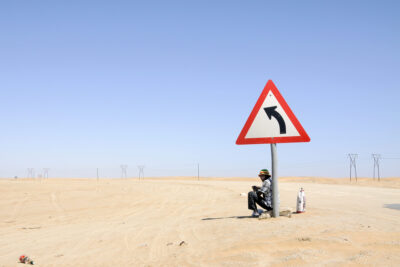Main content
In circumstances where resources are scarce, one has to use simple methods. These methods are not automatically poor.
Red reflex examination
An example of a simple, efficient method is the red reflex examination: if the light of the ophthalmoscope is aligned along the visual axis, the pupillary space will appear as a reddish colour, the so-called red reflex. This is a reflection of the fundus colour, back through the vitreous, lens and cornea (same as red pupils on a photo). The red reflex is observed by holding the ophthalmoscope 30-50 cm., dialling the “wheel” of the ophthalmoscope to get the proper reflex and to focus well: dial the wheel to +2-+3. Any opacity located in the optical pathway will block this bright reflex and appear as a dark spot, or shadow. This shadow can be fixed or mobile: to judge mobility ask the patient to look up and down and then straight again; if there is a moving shadow coming along it must be in a fluid or gel: theoretically also in the anterior chamber, in practice in the vitreous.
If the opacity is stationary it is located in the lens (cataract) or on the cornea (scar, foreign body).
See the floaters
With a shift these days to more posterior segment pathology, including uveitis posterior, this examination is becoming more important. If there is a very poor or absent red reflex this is usually due to a dense cataract, or, in rare cases, to a vitreous haemorrhage, retinal detachment or tumour.
When looking with + 10 D when looking at 10 cm (= 1/10 m) the red reflex can be judged better but there is the risk of pupillary constriction due to more light. In that case, it is best observed after mydriasis with a short acting anticholinergic drug as tropicamide (do not use atropine because the dilating effect of one drop can last up to 14 days). Adding a sympathicomimetic drug (such as phenylephrine 2.5%) to stimulate the musculus dilatator can help to get a wider pupil. Realize that in darker people it will be harder to get dilatation.
If dilatation does not result in a wide round pupil there probably will be synechiae posteriores: the iris is attached to the lens, a common clinical feature in uveitis. A trauma of the anterior part of the eye can result in a uveitis with synechiae posteriores but also in synechiae anteriores due to a previous perforation: the iris is plugging the hole in the cornea. Most of the times a corneal scar is visible then.
Inspection with the slit aperture, most of the times present on the ophthalmoscope and a loupe (or spectacles S+3) can help to differentiate. Let the slit come from the side.
Examine the pupils
Before dilating you will examine the pupillary reflex with the light of the ophthalmoscope. (Pupils Equally Reacting to Light and Accommodation (PERLA)). As with judging the red reflex this is best done in a semi-dark room.
The ophthalmoscope is meant to see the fundus.[1] Dilatation is necessary because, due to the pupillary reflex, the pupil is contracting and it is hard to see the retina through a small hole. Looking at a fundus of a dark person can be more difficult than of a Caucasian due to the darker appearance of the retina. Realize that your refraction and that of the patient together have to be zero in order to get a sharp image.
Take the highest positive value because then the accommodation (of you or the patient) will be minimal. The value that shows a sharp picture of the retina also gives you an indication what the refraction error is.
An ophthalmoscope head is attached to a separate handle for the energy. Most handles, suitable for an ophthalmoscope head can hold an otoscope. So handy for the general practitioner.
Determine refraction
The direct ophthalmoscope can also be used as an ‘auto refractor’: let the patient look through the ophthalmoscope and let him dial the wheel until the E chart is best seen. The chosen number on the wheel is a rough indication of the refractive error, if any.
Two more ophthalmological devices can be added. A retinoscope uses the red reflex to determine the refractive error. This can be learned with a little patience. [2] A special part is available for indirect ophthalmoscopy; together with a 20 dioptre lens one can judge the (peripheral) retina. The direct ophthalmoscope is excellent for judging the central retina. Recently there is also the possibility to use a special part so that even pictures can be made with an iPhone. [3] It can also be used as a loupe with illumination, not only for eye purposes, and even as a torch for getting home. So it is an essential instrument for a general doctor in simple circumstances.
References
- tutorial direct ophthalmoscopy, http://www.youtube.com/watch?v=leMexvs9HVU
- tutorial retinoscopy (skiascopy), http://www.youtube.com/watch?v=ezOoPKZwNDk
- http://www.welchallyn.com/promotions/iExaminer/index.html



















































